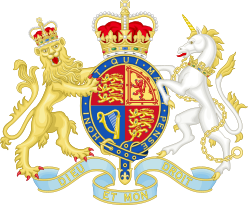Henry Bathurst, 3. Earl Bathurst
Henry Bathurst, 3. Earl Bathurst KG PC (* 22. Mai 1762; † 27. Juli 1834 in London) war ein britischer Adliger und Politiker.
Familie
Er war der älteste Sohn von Henry Bathurst, 2. Earl Bathurst. Am 1. April 1789 heiratete er Georgina (* 6. Dezember 1765; † 20. Januar 1841), die Tochter von Lord George Henry Lennox und Enkelin des 2. Duke of Richmond. Das Paar hatte vier Söhne und zwei Töchter. Sein ältester Sohn Henry George (* 24. Februar 1790; † 25. Mai 1866) erbte den Titel als 4. Earl Bathurst.
Politiker
Bis 1779 besuchte er das Christ Church College der Universität Oxford. 1783 wurde er Abgeordneter im House of Commons für Cirencester in Gloucestershire, bevor er beim Tod seines Vaters am 6. August 1794 dessen Titel erbte und dessen Platz im House of Lords einnahm. Dank seiner Freundschaft zum Premierminister William Pitt dem Jüngeren wurde er 1783 Lord der Admiralität. Von 1789 bis 1791 war er Lord des Schatzamtes.
Als Pitt im Mai 1804 ein zweites Mal Premierminister wurde, übernahm Bathurst das Amt des Leiters der Royal Mint (Master of the Mint). Er hatte diese Position bis 1806 und ein weiteres Mal von 1807 bis 1812. Unter den Premierministern William Cavendish-Bentinck, 3. Duke of Portland und Spencer Perceval war er Präsident des Handelsamtes (Board of Trade). 1809 war er von Oktober bis Dezember Außenminister.[1] Am 11. Juni 1812 wurde er Kriegs- und Kolonialminister, als der amtierende Minister, Robert Jenkinson, 2. Earl of Liverpool, das Amt des Premierministers übernahm.[2] Bathurst bekleidete diese Position bis zum 30. April 1827 und verdankte es diesem Amt, dass diverse abgelegene Orte nach ihm benannt wurden. 1817 wurde er in den Hosenbandorden aufgenommen.
In der Regierungszeit von Arthur Wellesley, 1. Duke of Wellington, hatte er vom 28. Januar 1828 bis zum 22. November 1830 das Amt des Lord President of the Council inne,[3] ein Amt, das bereits sein Vater von 1779 bis 1782 innegehabt hatte. Er unterstützte die Katholikenemanzipation und war ein Gegner der 1832 verabschiedeten Parlamentsreform.
Ehrungen
Nach Henry Bathurst wurden unter anderem benannt:
- die Stadt Bathurst in der kanadischen Provinz New Brunswick
- die 1815 gegründete Stadt Bathurst im australischen Bundesstaat New South Wales
- die 1816 gegründete Hauptstadt von Gambia, 1973 in Banjul umbenannt
- die 1819 entdeckte Bathurst-Insel im Norden Kanadas
- die Bathurst-Insel im Norden Australiens
- der 1820 gegründete Ort Bathurst in der südafrikanischen Provinz Ostkap.
Einzelnachweise
- ↑ Powicke & Fryde: Handbook of British Chronology. Second Edition, London, 1961, S. 117
- ↑ Powicke & Fryde: Handbook of British Chronology. Second Edition, London, 1961, S. 118
- ↑ Powicke & Fryde: Handbook of British Chronology. Second Edition, London, 1961, S. 138
Weblinks
- Henry Bathurst, 3rd Earl Bathurst of Bathurst auf thepeerage.com, abgerufen am 14. September 2016.
- Henry Bathurst im Hansard (englisch)
| Vorgänger | Amt | Nachfolger |
|---|---|---|
| Henry Bathurst | Earl Bathurst 1794–1834 | Henry Bathurst |
| John Smyth | Master of the Mint 1804–1806 | Charles Spencer |
| William Eden | President of the Board of Trade 1807–1812 | Richard Trench |
| Charles Bathurst | Master of the Mint 1807–1812 | Richard Trench |
| Robert Jenkinson | Secretary of State for War and the Colonies 1812–1827 | Frederick Robinson |
| William Bentinck | Lord President of the Council 1828–1830 | Henry Petty-Fitzmaurice |
| Personendaten | |
|---|---|
| NAME | Bathurst, Henry, 3. Earl Bathurst |
| KURZBESCHREIBUNG | britischer Politiker |
| GEBURTSDATUM | 22. Mai 1762 |
| STERBEDATUM | 27. Juli 1834 |
| STERBEORT | London |
Auf dieser Seite verwendete Medien
Henry Bathurst, 3rd Earl Bathurst, by William Salter (died 1875). See source website for additional information.
This set of images was gathered by User:Dcoetzee from the National Portrait Gallery, London website using a special tool. All images in this batch have been confirmed as author died before 1939 according to the official death date listed by the NPG.Autor/Urheber: Sodacan, Lizenz: CC BY-SA 3.0
Royal Coat of Arms of the United Kingdom of Great Britain and Northern Ireland in the style used by the Government of Queen Elizabeth II from 1952 to 2022 (as used in all places except Scotland).
| “ | Quarterly, First and Fourth Gules three lions passant guardant in pale Or armed and langued Azure (for England), Second quarter Or a lion rampant within a double tressure flory counter-flory Gules (for Scotland), Third quarter Azure a harp Or stringed Argent (for Ireland), the whole surrounded by the Garter; for a Crest, the imperial crown Proper; for Supporters, dexter a lion rampant guardant Or crowned as the Crest, sinister a unicorn Argent armed, crined and unguled Proper, gorged with a coronet Or composed of crosses patée and fleurs de lys a chain affixed thereto passing between the forelegs and reflexed over the back also Or; Motto 'Dieu et mon Droit’ ('God and my Right') below the shield. | ” |
- PINCHES, J.H & R.V., The Royal Heraldry of England, 1974, Heraldry Today.


